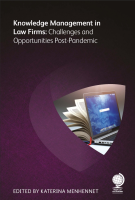
Author(s): David Laud
Publication date: Jul 2019
Format: Softback
Pages: 110
Price: £159.00
ISBN: 9781783583768
How our eBook platform works
How permanent access, multi-user eBooks work
In this current period of the 21st century, our workplace is more diverse than at any other point in time. This diversity is due to a broadening ethnic mix, gender representation and spread of generations. Greater mobility, socioeconomic and legislative developments account in the most part for the first two factors, but what of the third? What has caused this widening of the generational spectrum in the workplace?
Historically in law firms, the older generation, in particular partners, would move toward retirement and hand over the reins to the next oldest. In today’s world of work, with improved healthcare, increased life expectancy, greater knowledge of fitness, and in part historic anxiety over the effects of the global recession, there’s a reluctance to rush to retirement.
Specifically, here we’re talking about the Baby Boomer generation, who are aged between 55 and 73 and, as the name suggests, are not in short supply. Typically schooled in a traditional hierarchical command management style they are the generation now most often faced with tackling the integration of disruptive and aspirational Gen X’ers and more technologically adept and collaborative (but considered less driven) Gen Y or Millennials. They’re also now seeing the newest arrivals, Gen Z, who bring an even greater affinity to everything digital but are not quite so comfortable with matters of an interpersonal nature. It’s quite a challenge and the reason why this publication delves into the differences between the generations, their influences, preferences, strengths, and weaknesses, to better understand and thereby manage the staff who fall into the respective age groupings.
The consequence of older generations remaining in a post is a fascinating and yet challenging prospect. Law firms can be presented with the task of managing at least four and sometimes five different age groups. It becomes five if we add that fit and able and working who are in their mid-70s and beyond, who belong to the “silent generation”. Multiple generations in one practice with the oldest holding on to the power base and ownership can create pressure points for younger, ambitious professionals seeking a stake rather than simply a “steady job”. It’s likely that in many law firms those appealing for a place at the partners’ table will now be coming from Generation Y or Millennials aged in their early to late 30s. Millennials are considered more focused on experiences outside of work than within, but this does not hide or diminish their need for recognition and reward. Gen X’ers will mostly be in their 40s and early 50s and the majority of this group will already have established their partnership credentials. In other words, if it was going to happen for them, it’s likely to have been handled one way or another.
The X’ers are something of a filling in the career sandwich, with slices of Millennial below and Boomer above. There is a smaller population of Generation X and they will need to find appropriate skills and knowledge to work with their younger and older generational colleagues for mutual gain. By 2020, 50 percent of the US workforce will be made up of Millennial or the “Y” Generation; by 2030 it will be 75 percent. These Millennial employees, born between 1980 and 1996, have ridden several seismic waves of change - from political and environmental to communication and technological innovation - and this pace of change shows little sign of abating.
Having experienced an ever more connected, digitally-driven world, Millennials are now moving through firms to take greater responsibility, head teams, run departments or entire businesses, and in certain cases creating their own version of a law firm.
This book explores the various generations within law firms and the challenges, threats, and opportunities they face as staff deal with colleagues from younger or older groups be they Baby Boomer or Generations X, Y (Millennial) or the next wave of “Z’s” as they enter the world of work.







